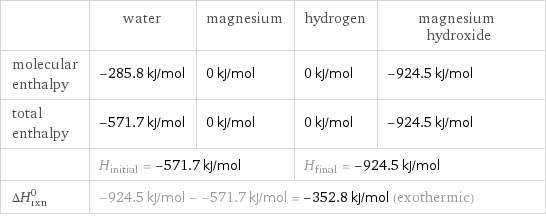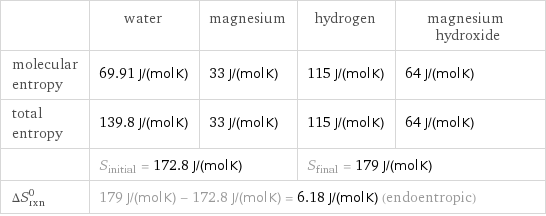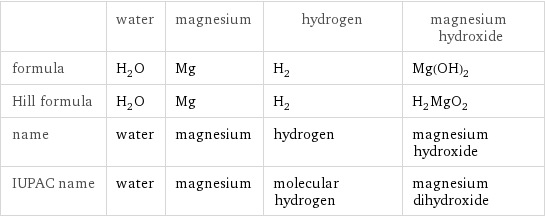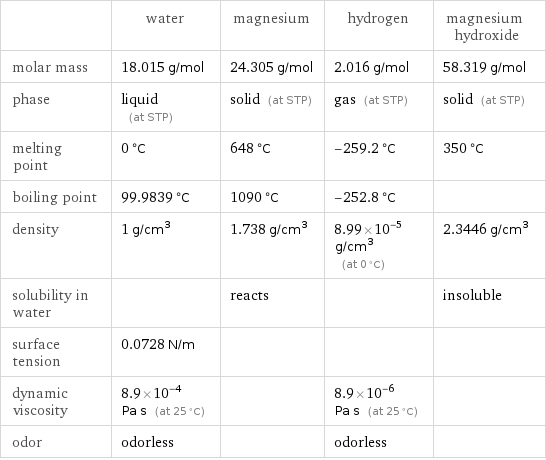Input interpretation

H_2O water + Mg magnesium ⟶ H_2 hydrogen + Mg(OH)_2 magnesium hydroxide
Balanced equation

Balance the chemical equation algebraically: H_2O + Mg ⟶ H_2 + Mg(OH)_2 Add stoichiometric coefficients, c_i, to the reactants and products: c_1 H_2O + c_2 Mg ⟶ c_3 H_2 + c_4 Mg(OH)_2 Set the number of atoms in the reactants equal to the number of atoms in the products for H, O and Mg: H: | 2 c_1 = 2 c_3 + 2 c_4 O: | c_1 = 2 c_4 Mg: | c_2 = c_4 Since the coefficients are relative quantities and underdetermined, choose a coefficient to set arbitrarily. To keep the coefficients small, the arbitrary value is ordinarily one. For instance, set c_2 = 1 and solve the system of equations for the remaining coefficients: c_1 = 2 c_2 = 1 c_3 = 1 c_4 = 1 Substitute the coefficients into the chemical reaction to obtain the balanced equation: Answer: | | 2 H_2O + Mg ⟶ H_2 + Mg(OH)_2
Structures

+ ⟶ +
Names

water + magnesium ⟶ hydrogen + magnesium hydroxide
Reaction thermodynamics
Enthalpy

| water | magnesium | hydrogen | magnesium hydroxide molecular enthalpy | -285.8 kJ/mol | 0 kJ/mol | 0 kJ/mol | -924.5 kJ/mol total enthalpy | -571.7 kJ/mol | 0 kJ/mol | 0 kJ/mol | -924.5 kJ/mol | H_initial = -571.7 kJ/mol | | H_final = -924.5 kJ/mol | ΔH_rxn^0 | -924.5 kJ/mol - -571.7 kJ/mol = -352.8 kJ/mol (exothermic) | | |
Entropy

| water | magnesium | hydrogen | magnesium hydroxide molecular entropy | 69.91 J/(mol K) | 33 J/(mol K) | 115 J/(mol K) | 64 J/(mol K) total entropy | 139.8 J/(mol K) | 33 J/(mol K) | 115 J/(mol K) | 64 J/(mol K) | S_initial = 172.8 J/(mol K) | | S_final = 179 J/(mol K) | ΔS_rxn^0 | 179 J/(mol K) - 172.8 J/(mol K) = 6.18 J/(mol K) (endoentropic) | | |
Equilibrium constant
![Construct the equilibrium constant, K, expression for: H_2O + Mg ⟶ H_2 + Mg(OH)_2 Plan: • Balance the chemical equation. • Determine the stoichiometric numbers. • Assemble the activity expression for each chemical species. • Use the activity expressions to build the equilibrium constant expression. Write the balanced chemical equation: 2 H_2O + Mg ⟶ H_2 + Mg(OH)_2 Assign stoichiometric numbers, ν_i, using the stoichiometric coefficients, c_i, from the balanced chemical equation in the following manner: ν_i = -c_i for reactants and ν_i = c_i for products: chemical species | c_i | ν_i H_2O | 2 | -2 Mg | 1 | -1 H_2 | 1 | 1 Mg(OH)_2 | 1 | 1 Assemble the activity expressions accounting for the state of matter and ν_i: chemical species | c_i | ν_i | activity expression H_2O | 2 | -2 | ([H2O])^(-2) Mg | 1 | -1 | ([Mg])^(-1) H_2 | 1 | 1 | [H2] Mg(OH)_2 | 1 | 1 | [Mg(OH)2] The equilibrium constant symbol in the concentration basis is: K_c Mulitply the activity expressions to arrive at the K_c expression: Answer: | | K_c = ([H2O])^(-2) ([Mg])^(-1) [H2] [Mg(OH)2] = ([H2] [Mg(OH)2])/(([H2O])^2 [Mg])](../image_source/add652e9e197876bec0a360d77cbcb62.png)
Construct the equilibrium constant, K, expression for: H_2O + Mg ⟶ H_2 + Mg(OH)_2 Plan: • Balance the chemical equation. • Determine the stoichiometric numbers. • Assemble the activity expression for each chemical species. • Use the activity expressions to build the equilibrium constant expression. Write the balanced chemical equation: 2 H_2O + Mg ⟶ H_2 + Mg(OH)_2 Assign stoichiometric numbers, ν_i, using the stoichiometric coefficients, c_i, from the balanced chemical equation in the following manner: ν_i = -c_i for reactants and ν_i = c_i for products: chemical species | c_i | ν_i H_2O | 2 | -2 Mg | 1 | -1 H_2 | 1 | 1 Mg(OH)_2 | 1 | 1 Assemble the activity expressions accounting for the state of matter and ν_i: chemical species | c_i | ν_i | activity expression H_2O | 2 | -2 | ([H2O])^(-2) Mg | 1 | -1 | ([Mg])^(-1) H_2 | 1 | 1 | [H2] Mg(OH)_2 | 1 | 1 | [Mg(OH)2] The equilibrium constant symbol in the concentration basis is: K_c Mulitply the activity expressions to arrive at the K_c expression: Answer: | | K_c = ([H2O])^(-2) ([Mg])^(-1) [H2] [Mg(OH)2] = ([H2] [Mg(OH)2])/(([H2O])^2 [Mg])
Rate of reaction
![Construct the rate of reaction expression for: H_2O + Mg ⟶ H_2 + Mg(OH)_2 Plan: • Balance the chemical equation. • Determine the stoichiometric numbers. • Assemble the rate term for each chemical species. • Write the rate of reaction expression. Write the balanced chemical equation: 2 H_2O + Mg ⟶ H_2 + Mg(OH)_2 Assign stoichiometric numbers, ν_i, using the stoichiometric coefficients, c_i, from the balanced chemical equation in the following manner: ν_i = -c_i for reactants and ν_i = c_i for products: chemical species | c_i | ν_i H_2O | 2 | -2 Mg | 1 | -1 H_2 | 1 | 1 Mg(OH)_2 | 1 | 1 The rate term for each chemical species, B_i, is 1/ν_i(Δ[B_i])/(Δt) where [B_i] is the amount concentration and t is time: chemical species | c_i | ν_i | rate term H_2O | 2 | -2 | -1/2 (Δ[H2O])/(Δt) Mg | 1 | -1 | -(Δ[Mg])/(Δt) H_2 | 1 | 1 | (Δ[H2])/(Δt) Mg(OH)_2 | 1 | 1 | (Δ[Mg(OH)2])/(Δt) (for infinitesimal rate of change, replace Δ with d) Set the rate terms equal to each other to arrive at the rate expression: Answer: | | rate = -1/2 (Δ[H2O])/(Δt) = -(Δ[Mg])/(Δt) = (Δ[H2])/(Δt) = (Δ[Mg(OH)2])/(Δt) (assuming constant volume and no accumulation of intermediates or side products)](../image_source/80162d0cadbb1f1e9e5160902700b393.png)
Construct the rate of reaction expression for: H_2O + Mg ⟶ H_2 + Mg(OH)_2 Plan: • Balance the chemical equation. • Determine the stoichiometric numbers. • Assemble the rate term for each chemical species. • Write the rate of reaction expression. Write the balanced chemical equation: 2 H_2O + Mg ⟶ H_2 + Mg(OH)_2 Assign stoichiometric numbers, ν_i, using the stoichiometric coefficients, c_i, from the balanced chemical equation in the following manner: ν_i = -c_i for reactants and ν_i = c_i for products: chemical species | c_i | ν_i H_2O | 2 | -2 Mg | 1 | -1 H_2 | 1 | 1 Mg(OH)_2 | 1 | 1 The rate term for each chemical species, B_i, is 1/ν_i(Δ[B_i])/(Δt) where [B_i] is the amount concentration and t is time: chemical species | c_i | ν_i | rate term H_2O | 2 | -2 | -1/2 (Δ[H2O])/(Δt) Mg | 1 | -1 | -(Δ[Mg])/(Δt) H_2 | 1 | 1 | (Δ[H2])/(Δt) Mg(OH)_2 | 1 | 1 | (Δ[Mg(OH)2])/(Δt) (for infinitesimal rate of change, replace Δ with d) Set the rate terms equal to each other to arrive at the rate expression: Answer: | | rate = -1/2 (Δ[H2O])/(Δt) = -(Δ[Mg])/(Δt) = (Δ[H2])/(Δt) = (Δ[Mg(OH)2])/(Δt) (assuming constant volume and no accumulation of intermediates or side products)
Chemical names and formulas

| water | magnesium | hydrogen | magnesium hydroxide formula | H_2O | Mg | H_2 | Mg(OH)_2 Hill formula | H_2O | Mg | H_2 | H_2MgO_2 name | water | magnesium | hydrogen | magnesium hydroxide IUPAC name | water | magnesium | molecular hydrogen | magnesium dihydroxide
Substance properties

| water | magnesium | hydrogen | magnesium hydroxide molar mass | 18.015 g/mol | 24.305 g/mol | 2.016 g/mol | 58.319 g/mol phase | liquid (at STP) | solid (at STP) | gas (at STP) | solid (at STP) melting point | 0 °C | 648 °C | -259.2 °C | 350 °C boiling point | 99.9839 °C | 1090 °C | -252.8 °C | density | 1 g/cm^3 | 1.738 g/cm^3 | 8.99×10^-5 g/cm^3 (at 0 °C) | 2.3446 g/cm^3 solubility in water | | reacts | | insoluble surface tension | 0.0728 N/m | | | dynamic viscosity | 8.9×10^-4 Pa s (at 25 °C) | | 8.9×10^-6 Pa s (at 25 °C) | odor | odorless | | odorless |
Units
